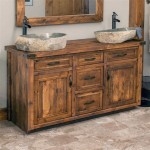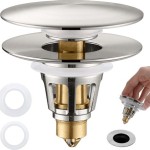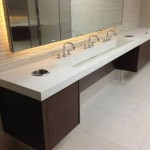White Oak Bathroom Vanity With Sink: A Comprehensive Guide
The white oak bathroom vanity with sink has emerged as a popular choice for homeowners seeking to blend durability, aesthetic appeal, and functional design in their bathroom spaces. This article delves into the various aspects of white oak vanities, exploring their benefits, design considerations, installation guidelines, and maintenance tips. The intention is to provide a comprehensive understanding of why white oak is a desirable material and how to select and maintain a white oak bathroom vanity with sink to ensure longevity and beauty.
Understanding White Oak as a Material
White oak (Quercus alba) is a hardwood known for its strength, density, and resistance to decay and moisture. It is a preferred choice for furniture making, flooring, and cabinetry, including bathroom vanities. The closed-grain structure of white oak contributes to its water resistance, a crucial factor in humid bathroom environments. Unlike some other woods, white oak contains tyloses, cellular structures that block the vessels and make it nearly impervious to water penetration. This inherent water resistance minimizes the risk of warping, rotting, or swelling, ensuring the longevity of the vanity. Furthermore, white oak exhibits a natural resistance to fungal growth and insect infestation, reducing the likelihood of damage from these sources.
Beyond its practical qualities, white oak possesses an attractive grain pattern ranging from straight to slightly irregular, providing visual interest and character. The color of white oak ranges from light tan to pale yellow-brown, allowing it to complement various bathroom design styles, from contemporary to traditional. The natural tone of white oak can be easily stained or finished to achieve a desired aesthetic, making it a versatile material for bathroom vanities. The finishing process can enhance the wood's natural beauty and provide an additional layer of protection against moisture and wear.
Compared to other hardwoods, white oak is readily available and sustainably harvested. Responsible forestry practices ensure that the use of white oak for furniture production does not contribute to deforestation or environmental degradation. This makes white oak a more environmentally conscious choice for homeowners seeking to minimize their ecological footprint.
Design Considerations for White Oak Bathroom Vanities with Sinks
When selecting a white oak bathroom vanity with sink, several design considerations come into play. These include size and configuration, sink type, countertop material, hardware selection, and overall style. Approaching these elements with careful consideration will result in a vanity that not only meets functional needs but also enhances the aesthetic appeal of the bathroom.
The size of the vanity should be proportional to the bathroom space. Measure the available area carefully, considering door swings, toilet placement, and other fixtures. A vanity that is too large can make the bathroom feel cramped, while one that is too small may not provide adequate storage or counter space. White oak vanities are available in a range of sizes, from compact units suitable for powder rooms to double vanities designed for larger bathrooms.
The configuration of the vanity, including the number of drawers, cabinets, and open shelving, should be tailored to storage needs. Drawers are ideal for organizing smaller items such as toiletries and grooming supplies, while cabinets offer space for larger items like towels and cleaning products. Open shelving can be used to display decorative items or store frequently used items. The internal organization of the vanity, such as adjustable shelves and drawer dividers, can further enhance its functionality.
The choice of sink is another crucial design consideration. Undermount sinks create a seamless look and are easy to clean, while vessel sinks add a touch of contemporary flair. Integrated sinks, made from the same material as the countertop, offer a minimalist aesthetic and eliminate the need for seams. The size and shape of the sink should be appropriate for the vanity size and the intended use. Single-basin sinks are suitable for smaller bathrooms, while double-basin sinks provide added convenience for shared bathrooms.
Countertop material selection significantly impacts the overall look and functionality of the vanity. Popular countertop materials include granite, quartz, marble, and solid surface. Granite is a durable and heat-resistant option with a natural stone appearance, while quartz is a low-maintenance and stain-resistant alternative. Marble offers a luxurious aesthetic but requires more care to prevent staining and etching. Solid surface countertops are non-porous and easy to clean, making them a practical choice for bathrooms. The countertop color and pattern should complement the white oak vanity and the overall bathroom design.
Hardware selection, including knobs, pulls, and faucets, provides an opportunity to add personality and style to the vanity. Metal finishes such as brushed nickel, chrome, and oil-rubbed bronze are popular choices. The hardware style should complement the overall design aesthetic of the bathroom, whether it is modern, traditional, or transitional. The faucet style should also be considered, with options ranging from single-handle to widespread faucets.
The overall style of the vanity should harmonize with the existing bathroom decor. White oak vanities can be designed in various styles, from Shaker to modern. Shaker-style vanities feature simple, clean lines and recessed panel doors, while modern vanities often incorporate sleek, minimalist designs and floating configurations. Transitional vanities blend elements of both traditional and modern styles, offering a versatile option for any bathroom.
Installation and Maintenance of White Oak Bathroom Vanities with Sinks
Proper installation and regular maintenance are essential for ensuring the longevity and beauty of a white oak bathroom vanity with sink. Professional installation is recommended, especially if plumbing connections are involved. Correct installation prevents water damage, ensures proper drainage, and guarantees the stability of the vanity. Ignoring proper installation could compromise the integrity of the vanity and potentially lead to costly repairs.
Prior to installation, ensure that the subfloor is level and structurally sound. Any necessary repairs should be made before placing the vanity. Accurately measure and mark the location of the vanity, taking into account plumbing connections and wall irregularities. Level the vanity using shims if necessary, and secure it to the wall studs using screws. Connect the plumbing according to local codes, ensuring that all connections are watertight. Seal the countertop to the vanity to prevent water damage. Apply a bead of caulk along the back of the vanity where it meets the wall to prevent water from seeping behind it.
Regular maintenance is crucial for preserving the beauty and functionality of the white oak vanity. Clean the vanity regularly with a damp cloth and mild soap. Avoid using abrasive cleaners or harsh chemicals, which can damage the finish. Wipe up spills immediately to prevent staining. Dust the vanity frequently to prevent buildup.
To protect the wood from moisture, consider applying a sealant or varnish periodically. This will create a barrier against water penetration and prevent warping or cracking. The frequency of sealant application will depend on the humidity levels in the bathroom and the type of finish used on the vanity.
Inspect the vanity regularly for signs of wear and tear, such as scratches, dents, or water damage. Repair any damage promptly to prevent it from worsening. Minor scratches can often be repaired with a touch-up pen or furniture polish. Dents can be filled with wood filler and sanded smooth. Water damage may require more extensive repairs, such as replacing damaged wood or refinishing the vanity.
Pay attention to the hardware on the vanity, such as knobs, pulls, and hinges. Tighten any loose screws and lubricate hinges to ensure smooth operation. Clean the hardware regularly to remove dirt and grime. Replace any damaged or corroded hardware to maintain the vanity's appearance and functionality.
By following these installation and maintenance guidelines, homeowners can ensure that their white oak bathroom vanity with sink remains a beautiful and functional centerpiece of their bathroom for many years to come. The combination of durable materials, thoughtful design, and proper care will create a bathroom space that is both stylish and practical.

Fallon 60 White Oak Double Vanity Rejuvenation

Regent 72 White Oak Vanity Double Sink The Cabinet

Fallon 36 White Oak Single Vanity Rejuvenation

White Oak Bathroom Vanity Single Sink

Regent 36 White Oak Vanity Left Sink The Cabinet

Bathroom Storage Inspiration 6 Stunning White Oak Vanities Styled To Sparkle

Ove Decors Albury 36 In White Oak Undermount Single Sink Bathroom Vanity With Engineered Marble Top The Vanities Tops Department At Com

Willow Collections Sonoma Oak 84 In W X 22 D 36 H Double Sink Bath Vanity White With 2 Empira Quartz Top Son Whok Emp Wt The Home Depot

White Oak Cabinets Bathroom Vanity Remodel Designs

60 Double Vanity In North American Oak With White Grain Stone Countertop No Mirror
Related Posts







